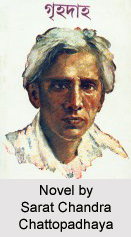 Grihadaha sets on the milieu of 20th century Bengal, represents the socio-cultural panorama of the contemporary era. The novel exhibits the conflict between the traditional Hindus and the Brahmans, centering the difference in customs, creeds and belief. A difference in the rural orthodox rearing and the urban upbringing cues one of the major issues, the novel deals with. Within the socio-cultural context, the novel portrays the interrelationship of the agonized soul tormented by the social discrimination based on religion. The novel Grihadaha is at the same time a piercing analysis of the human love and faith and the so-called integrity of a social institution of marriage.
Grihadaha sets on the milieu of 20th century Bengal, represents the socio-cultural panorama of the contemporary era. The novel exhibits the conflict between the traditional Hindus and the Brahmans, centering the difference in customs, creeds and belief. A difference in the rural orthodox rearing and the urban upbringing cues one of the major issues, the novel deals with. Within the socio-cultural context, the novel portrays the interrelationship of the agonized soul tormented by the social discrimination based on religion. The novel Grihadaha is at the same time a piercing analysis of the human love and faith and the so-called integrity of a social institution of marriage.
Author: - Sarat Chandra, the celebrated novelist of the Bengal Literary World, was born in 15th September 1876 in Debanandapur of Hooghly district. As a prophetic social reformer, Sarat Chandra was proficient enough to spot the socio-religious problems leapt in the society, with the advent of the Brahma religion. His novel Grihadaha is the fictional representation of the religious conflict reinforced by the social echelon based on pecuniary norms. Besides delineating a social picture, the novelist here, conveyed his own perspective about the contemporary socio-religious ethos.
Synopsis: - Presenting a realistic narrative on human relationships, the novel Grihadaha has the aura of a social drama in the core. The story line develops around three persons belonging to different stratum of the contemporary society. The strength of the social drama reinforced by religious discrimination intensifies with the mellowness of the love triangle between Suresh, Mahim and Achala. The poor and educated Mahim was the childhood friend of rich, conservative Suresh. Being born and brought up in a rural society he was habituated with the orthodoxy of the Hindu Brahmin family. Poverty was the inborn friend of Mahim and even in Kolkata it was due to fluctuating financial condition, he could not take admission in Medical College, following Suresh. Unlike Suresh, life was at more ease with Suresh, who has been reared up in the financial luxury. In the inseparable amity of Mahim and Suresh, Achala, an educated girl of Brahma Samaj appears as the glimmer of fire, which bewildered the relationship between the three.
The intellectual aura of Mahim inveigled Achala, who does not even care for the financial and social condition of Mahim, while marrying him. When the couple moved to village, the poverty and rigid conventionalism make it impossible to continue a blasé life with her beloved husband. Her smoldering unhappiness in family life takes the form of resentment towards Mrinal. However, the resentment and the unhappiness of the family life are dramatically visualized in the burning down of their house. Mahim falls ill, who was rescued by Suresh and nursed by Achala. In this course of time Achala gets infatuated with Suresh. She starts to feel that the intellectuality is nothing unless the man has a social and financial stability. Suresh, however felt different and with the evil design tempted Achala and eloped with her. However the novel concludes with the homecoming of Achala and her reconciliation with Hindu traditionalism.
The novel Grihadaha is analytical enough to point out the human relationships and the concept of love and friendship. The title of the novel signifies the flaming relationship between Mahim and Achala. The title "Grihadaha" at the same time also signifies the traumatized relationship of Achala and Mahim. Grihadaha represents the house including the family institution, which has burnt. In spite of being a family drama, Grihadaha pictures the society infested with narrow religious and social conflict, in which the social creatures are poor victims.
The novel first appeared in Bharatbarsha, in series, simultaneously with Dotta and Srikanto. In book form its first edition was published by GCS on 20th March 1920. The novel, highly applauded was translated into Gujarati in 1926 by Ratneshwar Vakil and to Hindi by Narayan Chandra Chatterjee in 1932. Pramathesh Barua`s film on Grihadaha was released on 9th October 1936. The Hindi version of the film by the same director called Manzil was also released in the same year.



















